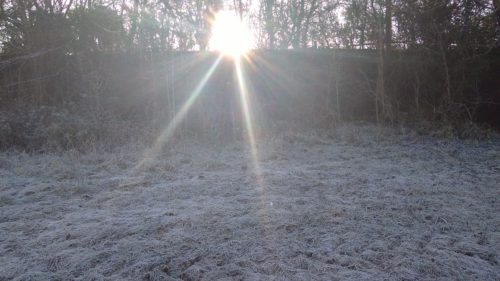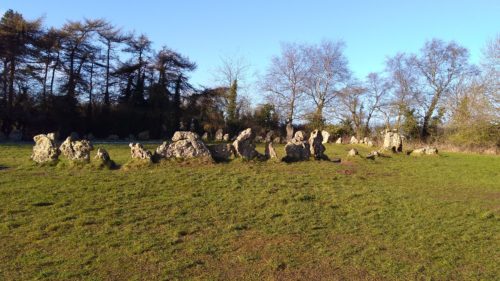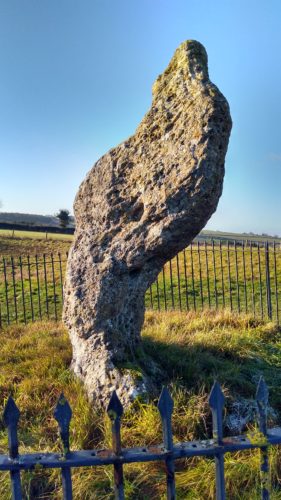 The beautiful thing about England, I thought, was that with a rail pass you could get just about anywhere in the country within a few hours. That was before I got there, of course. I hadn’t plotted the courses to the places I needed to visit in any great detail; I assumed that England, having an actual public transit system, would lead me anywhere I liked with no great effort on my part. Experience had proved otherwise. Two weeks into my trip, I had learned that if a map could be misread, I would misread it, and if a timetable could be missed, I would miss it. And for some reason, although I had loved every moment of riding the red buses around London, the buses outside of London — such as this one, boarding from Stratford-Upon-Avon — set me ill at ease. So it was with some trepidation that I asked my question of the driver as I counted out my change for a day ticket.
The beautiful thing about England, I thought, was that with a rail pass you could get just about anywhere in the country within a few hours. That was before I got there, of course. I hadn’t plotted the courses to the places I needed to visit in any great detail; I assumed that England, having an actual public transit system, would lead me anywhere I liked with no great effort on my part. Experience had proved otherwise. Two weeks into my trip, I had learned that if a map could be misread, I would misread it, and if a timetable could be missed, I would miss it. And for some reason, although I had loved every moment of riding the red buses around London, the buses outside of London — such as this one, boarding from Stratford-Upon-Avon — set me ill at ease. So it was with some trepidation that I asked my question of the driver as I counted out my change for a day ticket.

Midwinter sun on the road to the Rollright Stones. [Photo Credit: E. Scott.]
He frowned, but before he could speak, an elderly woman spoke up from the middle of the carriage. “It goes past the Rollright Stones, yes. But there’s no stop there.”
“Right,” said the driver. “We’ll pass by the road, but it’s probably a half mile walk to get to the stones themselves from that intersection. But if you’re okay with that, I can drop you off; just stay down here so I don’t forget about you.” I felt a little disappointed; I tried to spend every bus trip I made on the upper deck, preferably in the front row, so I could have a look at that authentic English countryside everyone brags about. But I took a seat behind the woman, who turned around in her seat and smiled at me.
“What are you studying, then?” she asked, already knowing that I was a student of some kind. Given that I finished my bachelor’s degree a decade ago, I’ve always been surprised by the assumption, but then I suppose it’s a safe guess for an American with a backpack better suited to books than camping gear. “History?”
“English, actually,” I said. “Doing research for my dissertation.”
“Really? Then what on earth do you want with the Rollright Stones?”
The answer, like everything else on this trip, had to do with Deryck: Deryck Alldrit, the civil engineer from Birmingham who founded the coven that eventually birthed the coven I had been born into, who had disappeared from our lives before my birth. According to my coven’s legends, Deryck had been part of a group that worshiped at the Rollright Stones before he came to the United States in the 1970s, and sometimes the stories even said the name of the group was “The Rollright Coven,” or the “Coven of the Rollright Stones.” All of that information came to me third- or fourth-hand, and the accuracy of the details remained suspect; indeed, some of the things I had learned on my trip had already made me have doubts about whether such a coven ever actually existed. But regardless of whether the coven had existed, the Rollright Stones obviously meant something to Deryck, or else he would never have mentioned them at all – and if they meant something to Deryck, then they meant something to me. That was, after all, why I was there.

The King’s Men. [Photo Credit: E. Scott]
I took my time, stopping to invoke the elements at the structure called the Whispering Knights before circling the field separating the knights from the main Rollright complex, the stone circle called the King’s Men. Across the road, the King’s Stone stood apart; the names all referred to a legendary king who, in his zeal to conquer all of England, ran afoul of the local witch of Long Compton, the small town just over the ridge from the King’s Stone. The witch preyed on the hubris of the king and his followers, causing them all to be turned to stone. According to the legend, sometimes the King’s Men returned to life, able to move about for just a few moments before resuming their stone shapes – an explanation for the mysterious movement of the stones, and their seemingly uncountable nature.
I walked around the circle, taking in the pale, pitted stones. I had a feeling much like the one I’d had at Stonehenge a few weeks before: the sense of time, deep time, that these stones had seen the rise and fall of kingdoms and empires, princes and gods, had been here before Christ and Buddha, had attracted the same puzzled wonder I held for three or four millennia; and the sense of a history more recent, if no less deep for that: Deryck had stood here once. Maybe just the once, for all I knew, but he had been here.
The mission was to find Deryck – to find out about him, of course, tracking down his death certificate and his childhood home and all the detritus of living we leave in our wake. But also to find him, the sense of his presence. To feel like I knew him. I don’t think I ever really achieved that. There, standing among the stones, I felt the closest to it.
I waited for other visitors to leave, and set up an altar in the middle of the circle – nothing fancy, just Pan and Willendorf, a glass of water, a wooden athame. I cast the circle, holding back a smirk: “This is the circle, this is the space between the worlds…” Well, yes, here, if anywhere.
In my Wiccan tradition, after the circle’s cast and the elements called, we invoke the gods by imagining ourselves as features of nature: animals, plants, weather patterns. We cast ourselves as three worldly forces. I had my eyes closed, fallen into a meditation; I was midway through the invocation, having just imagined myself as the grass between the ancient stones.
A hand lighted upon my shoulder, shaking me from the dream.
A smiling man with long hair and a beard, wearing a broad brown hat, held up two brass rods. They were bent into handles at one end. “Here,” said the stranger. “You look like the sort of person who could use these.”
It was not the sort of thing to argue with.
I took hold of the man’s dowsing rods and stepped forward, past my statues and tools. I had never dowsed before, and truthfully, it was one of those activities that lit up my sense of skepticism: despite, perhaps because of, having been raised by occultists, many such practices have always struck me as dubious. The rods did, in fact, seem to move of their own accord in my hands, slipping always to the right, guiding me in a spiral outward towards the stones. At some point I began laughing – because really, who would arrive at the Rollright Stones and find themselves walking an invisible labyrinth? It seemed absurd, and wonderful.
The old woman on the bus had told me one bit of Rollright lore before she got off just outside of Stratford-Upon-Avon. “The story is that if you can count the same number of stones on three consecutive passes, whatever you wish will come true.” I counted as I walked the spiral: 71. I counted again: 71! Still laughing, I rounded a third time, counting the rocks peaking up from the dirt, and wondering if Deryck had ever done the same, with or without the ghostly Coven of the Rollright Stones.
I counted 72 on the third pass. Very close. But not close enough for wishes.

The King’s Stone. [Photo Credit: E. Scott]
* * *
The views and opinions expressed by our diverse panel of columnists and guest writers represent the many diverging perspectives held within the global Pagan, Heathen and polytheist communities, but do not necessarily reflect the views of The Wild Hunt Inc. or its management.
The Wild Hunt is not responsible for links to external content.
To join a conversation on this post:
Visit our The Wild Hunt subreddit! Point your favorite browser to https://www.reddit.com/r/The_Wild_Hunt_News/, then click “JOIN”. Make sure to click the bell, too, to be notified of new articles posted to our subreddit.
